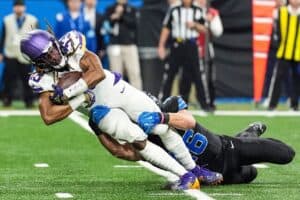Is the NFL experiencing a resurgence in its running back market?
Earlier this week, Derrick Henry signed a two-year contract extension with the Ravens, keeping him with the team through the 2027 season. The extension is worth $30 million total, with $25 million guaranteed.
An extension for Henry is no surprise. He was a perfect fit for Baltimore’s offense after coming over as a free agent in 2024. Henry rushed for 1,921 yards last season, averaged a career high 5.9 yards per carry, and tied for the NFL lead in rushing touchdowns (16). What is a bit surprising is the money. The $15 million per year Henry will average on the deal is the largest annual amount ever given to a running back over the age of 30 (Henry is 31). It also makes Henry the third-highest paid running back in the league, trailing only the Philadelphia Eagles’ Saquon Barkley ($20.6 million) and San Francisco 49ers’ Christian McCaffrey ($19 million).
The fact Baltimore would reward Henry with such a deal speaks to how much they value him as a player. But it speaks to something else as well. Running backs, after seeing their market diminish for several years, are experiencing a resurgence both financially and in their value to NFL offenses. Barkley authored an MVP-worthy season for Philadelphia last year, rushing for over 2,000 yards in leading the Eagles to a Super Bowl title. McCaffrey was hurt for much of last season, and his absence was a major reason the 49ers fell from being a Super Bowl contender to a 6-11 finish. And Henry galvanized a Baltimore offense that led the NFL in yards per game, rushing yards per game, and finished third in points per game.
All three have been rewarded contractually, which hints at a market re-set.
For several years, the opposite was true. Running back value was dropping like a bad stock. The biggest culprit for the decline was statistical. Increasingly, running backs showed a decrease in production once they entered their second contract. Rather than pay big money to backs who were losing the tread on their tires, teams were willing to move on sooner than later, or to make a team-friendly offer on the second deal.
Here are some of the notable contract extensions given to running backs between 2018 and 2023. These offers came at a time when the salary cap was exploding. It rose from $177 million per team in 2018 to $224 million in 2023. Despite that significant increase, running back contracts remained stagnant, and in some cases even declined:
David Johnson/Arizona Cardinals (Sept. 8, 2018): Three years, $39 million ($13 million annually)
Ezekiel Elliott/Dallas Cowboys (Sept. 4, 2019): Six years, $90 million ($15 million annually)
Le’Veon Bell/New York Jets (March 13, 2019): Four years, $52.5 million ($13.125 million annually)
Christian McCaffrey/Carolina Panthers (April 16, 2020): Four years, $64.064 million ($16.016 million annually)
Derrick Henry/Tennessee Titans (July 15, 2020) Four years, $50 million ($12.5 million annually)
Joe Mixon/Cincinnati Bengals (Sept. 2, 2020): Four years, $48 million ($12 million annually)
Dalvin Cook/Minnesota Vikings (Sept. 12, 2020): Five years, $63 million ($12.6 million annually)
Alvin Kamara/New Orleans Saints (Sept. 12, 2020): Five years, $75 million ($15 million annually)
Nick Chubb/Cleveland Browns: (Aug. 2, 2021): Three years, $36.8 million ($12.266 million annually)
Aaron Jones/Green Bay Packers (March 27, 2021): Four years, $48 million ($12 million annually)
It’s shocking when you look at that list to consider that Henry, at age 31, got a better contract from Baltimore ($15 million annually) than he did at age 26 from Tennessee ($12.5 million). Obviously, Henry’s production has remained consistent. But the increased value of top running backs the past two years has played a factor, too.
Barkley, McCaffrey and Henry — the three highest paid backs in the league, all earning at least $15 million per season — are all key components of highly successful teams. The NFL is a copy-cat league, and other teams have taken notice. The Colts extended Jonathan Taylor at $14 million per season in 2023, which could be a steal considering some of the new deals getting done. The Vikings extended Aaron Jones this off-season at $10 million per season, which was a nice number for a 30-year-old back. The Las Vegas Raiders selected Ashton Jeanty sixth overall in last month’s NFL draft with the hope he can impact their offense the way Barkley, McCaffrey and Henry have. Five running backs were drafted in the first two rounds, the most since 2018. A renaissance-of-sorts seems underfoot.
Many teams will still operate under the belief that effective backs can be found in the mid-to-late rounds, that backs have shelf lives that are too short to invest high picks in, and that their burn-out rate makes them unworthy of lucrative second contracts. But the success of Barkley, McCaffrey and Henry, as well as Bijan Robinson, Jahmyr Gibbs and Jonathan Taylor — all of whom were Top 50 picks — has other teams thinking about buying high at the position. And, if that back proves to be durable and productive, they might just get paid on their second deal as well.
It’s too early to tell whether this resurgence will last. For now, though, running backs appear to be back.
